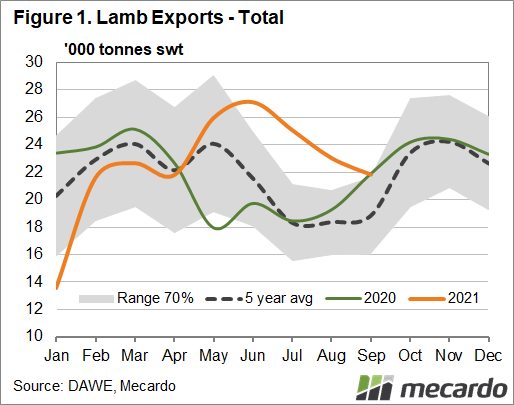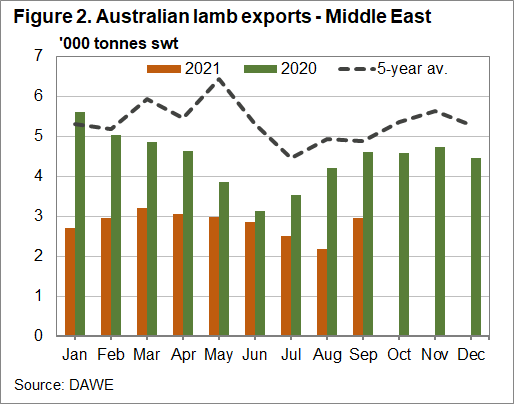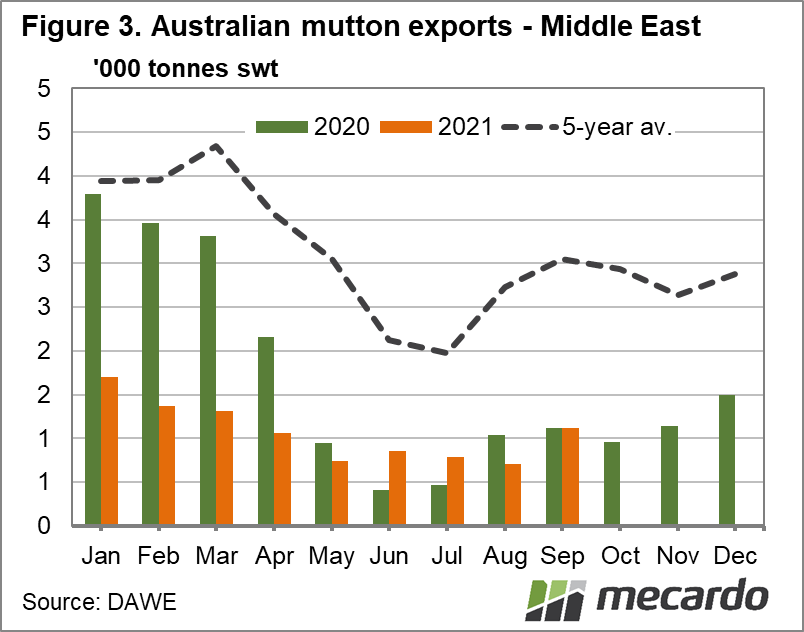Australian lamb exports have climbed higher year-on-year so far, and Meat and Livestock Australia’s latest predictions expect them to remain that way for the rest of 2021. Mutton exports however continue to feel the pinch of the domestic flock rebuild, well behind last year’s volumes, and with MLA estimating them to finish 2021 making up just 30% of all sheepmeat exports, down from the usual 38%. Lamb exports for the year are expected to finish 6% higher, while mutton will be back 15% - another 3% lower than forecast in June.
After experiencing three consecutive months of record monthly volumes of lamb exports, September totals fell back below year-ago levels, and within the average 70% range. Lamb exports for the year-to-September are now 5% higher than last year after their winter surge, but remain 28% below the record levels set in 2019. The Chinese lamb market had a slow start to the year, but has been above year-ago levels for the past five months, with September volumes up 20% compared to the same month in 2020. Lamb exports to China for the year-to-April were down 22% year-on-year, but are now 2% higher for the year-to September.
Mutton exports for the month of September were down 17% year-on-year, and total volumes are down 12% for the year-to-September. China has remained the largest market this year, currently taking 40% of all Australian mutton exports, and volumes up 9% for the year-to-September. However, the month of September itself did see a slow-down in mutton to China, with 35% less headed there compared to the same month last year. Mutton exports remain tight mainly due to domestic demand for restockers, and total mutton exports for the year-to-September are 29% lower than the same period in 2019. Chinese exports are in line with this, at 30% lower than 2019 levels.
Exports to the Middle East have been some of the hardest hit by Covid-19 impacts in the past 18 months, as freight options have diminished or stalled altogether. The Middle East market prefers chilled lamb product, not frozen, but also until recently has had short shelf-life regulations (a number of Middle East markets have now extended this to 90 days). However, as air-freight options have been minimal, and global shipping continues to experience significant delays, getting sheepmeat to the Middle East remains a hurdle. Mutton exports to the Middle East are 42% lower for the year-to-September compared to 2020, and 66% behind 2019 levels. Lamb is back 36% year-on-year, and 62% on 2019. (figure 2 & 3)
What does it mean?
Major international sheepmeat market demand has not waived, despite continued high prices, keeping in line with domestic supply and then some. China’s rebound in the second half of 2021 has been positive, and while not to be fixed overnight, issues with freight to the Middle East should be resolved as soon as global transport finds its post-pandemic normal.
Have any questions or comments?
Key Points
- Lamb exports are up 5% for the year-to September, while mutton exports have dropped 12%.
- MLA estimates have lamb exports rising 6% year-on-year in 2021, and mutton falling by 15%.
- Sheepmeat exports to the middle east have been hit by Covid-19 impacts, while China volumes have increased in the second half of the year.
Click on figure to expand
Click on figure to expand
Click on figure to expand
Data sources: MLA, Mecardo















